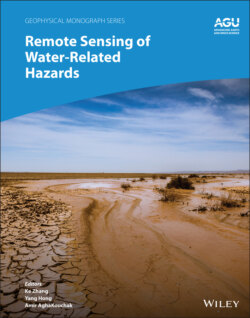Читать книгу Remote Sensing of Water-Related Hazards - Группа авторов - Страница 28
2.3. METHODOLOGY 2.3.1. Statistic Metrics
ОглавлениеDifferent types of statistical metrics are applied to evaluate the accuracy of various precipitation products, including the Pearson correlation coefficient (CC), mean error (ME), and root mean square error (RMSE), which are widely used in previous studies. We also used the Kling‐Gupta efficiency (KGE') statistics proposed by Gupta et al. (2009) and modified by Kling et al. (2012). KGE' considers the contribution of correlation, deviation, and variability, and its calculation formula is as follows:
(1)
(2)
(3)
where r is the CC between reference (abbreviated as ref) and target (abbreviated as tar), β is the bias ratio, γ is the variability ratio, μ is the mean precipitation, CV is the coefficient of variation, and σ is the standard deviation of precipitation. KGE' ranges between negative infinity and 1.
In addition, the critical success index (CSI) as a representative of contingency metrics is utilized to demonstrate the capability of precipitation products in detecting precipitation occurrence. CSI is expressed as a function of the probability of detection (POD) and false alarm ratio (FAR), and is calculated as below:
(4)
(5)
(6)
where H is the number of hit events where both reference and target data sets detect positive precipitation, M is the number of missed events where the reference data set detects precipitation but the target data set neither, and F is the number of false alarms, which is inverse with M. The calculation of CSI requires a threshold to determine rain/no rain events. Usually, a value larger than zero such as 1 mm/d is adopted because both gauges and satellite/reanalysis are prone to large uncertainties for light precipitation. However, a unified threshold can either be too large for dry regions or too small for humid regions. For example, the 1 mm/d threshold will result in the loss of many light precipitation samples in TP, XJ, and NE. Therefore, this study adopts the smaller one between the 20th percentile of mean daily precipitation and 1 mm/d, meaning that varying rain/no rain thresholds are applied for each rain gauge. Thus, there are enough samples for the validation of precipitation data sets even in arid regions. However, it should be noted that dynamic thresholds result in nonuniform evaluation criteria in space. Since our major objective lies in the comparison between different data sets, this problem is largely avoided.
